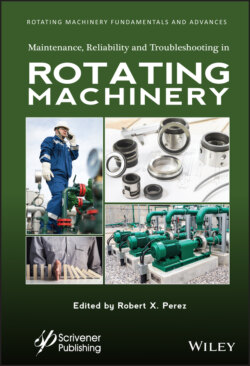Читать книгу Maintenance, Reliability and Troubleshooting in Rotating Machinery - Группа авторов - Страница 27
Machinery Reliability Assessment Example Background
ОглавлениеFour 1200 rpm, 1500 hp, reciprocating, natural gas compressors (see Figure 1.8) are installed in parallel service. Each compressor is driven directly with a synchronous, electric motor. The gas processing facility needs all four compressors running to achieve design processing rates. If one of the compressors is down, the processing plant must cut back its throughput until it can be repaired and restarted. A process slowdown loses the plant about $50,000 per day when one compressor is unavailable.
Figure 1.8 Reciprocating gas compressor cylinders.
There are several types of potential consequences associated with these four compressors. First, there is a significant economic penalty related to a process outage. The actual loss is equal to the length of the outrage times the length of the outage. A two-day outage will lose $100,000, while a 30-day outage represents a loss of $1,500,000. Second, there is a safety risk related to a major product release and subsequence fire scenario. Based on the existence of detailed emergency operating procedures and automatic isolation valving, the safety consequence level can be seen to be at medium. The third type of potential consequence is related to machinery damage. A catastrophic compressor failure could result in major damage and repairs costs. For example, a main bearing failure could potentially result in a crankshaft failure and even frame damage. If an undetected primary failure goes undetected, repair costs can escalate rapidly. In our example, since each compressor is rated at 1500 hp, we will rate the potential consequences of a major failure to be high.
After assessing all the potential consequences, we have rated the process consequence at a medium to high level, the potential safety consequences at a medium level, and the potential consequences of machine damage at a high level.
